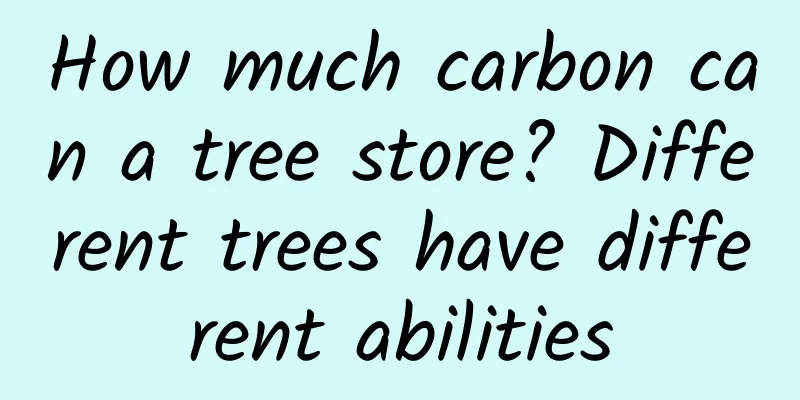How much carbon can a tree store? Different trees have different abilities

|
When it comes to reducing carbon emissions, we always think of planting trees. So how does a big tree help us fix carbon and reduce emissions? We know that the life cycle from a seed to a big tree probably goes through different growth and development stages such as seed germination - seedling growth - plant maturity - aging and death. In suitable environmental conditions, seeds take root, sprout, and grow leaves, becoming seedlings with complete roots, stems and leaves; the roots of seedlings absorb water and inorganic matter from the soil, and the leaves absorb CO2 for photosynthesis, accumulating organic nutrients for their own cells to continuously divide and grow, the stems become taller and thicker, the branches above the ground and the roots underground gradually increase, and the space occupied gradually expands, the reproductive organs mature, and begin to bloom and bear fruit, produce seeds, and become big trees with deep roots and lush leaves; after growing and multiplying day after day and year after year, the growth of mature plants gradually weakens, the tree body withers, and finally ages and dies, and its dead branches, stems, and root residues are gradually decomposed by microorganisms, etc., and then converted into inorganic matter, returning to nature for reuse by other plants. This is a material cycle process, and countless such material cycles on the earth merge into the overall material cycle of the biosphere. Here, from seed to tree, it is a process of carbon fixation. Through photosynthesis, seedlings rely on light energy to combine the CO2 absorbed from the air with the water obtained from the soil, transform it into sugars, and release oxygen; these sugars are transported to the whole plant, and the carbon in the sugars is stored in the whole tree, from roots to buds, everywhere; and the carbon in the dead branches and leaves of the trees is decomposed and returned to and stored in the soil. The fixed carbon in the tree and the soil is increasing, the plants become strong, and the soil becomes fertile, forming a good growth environment. From the decline of the tree to the seed, it is another process of carbon release. Plants are producers in nature. Herbivores and carnivores feed through the food chain and absorb and transform the carbon stored in plants into their own bodies; the respiration of animals and plants and the decomposition of animal and plant residues by microorganisms release the fixed carbon absorbed by them into the atmosphere in the form of CO2; organic residues that are not completely decomposed are buried underground or piled on the seabed, converted into coal, oil and natural gas. Humans mine these fuels, and the fuels are burned, which also emits CO2 into the atmosphere. It can be seen that the life cycle of a single tree is a carbon cycle process in the biosphere. Under natural conditions, this carbon cycle is generally in a relatively stable equilibrium state. Mangroves, the picture is from Tuchong.com Interestingly, the life cycle of trees can be actively regulated by humans. Usually, the life span of trees is only a few decades to hundreds of years, but under suitable conditions, some trees can grow for thousands of years or even longer. For example, there are many thousand-year-old white pine, Chinese pine, Sophora japonica, and Ginkgo trees in the Jietai Temple in Mentougou, Beijing. There are a large number of ancient trees and famous trees growing healthily in various places in my country. People can also effectively improve the quality of forests and green spaces through reasonable planning, planting, nurturing, felling, management and other measures, forming a multi-layer, mixed, different-age, native, beautiful, and stable ecosystem to achieve the goal of sustainable carbon fixation; through scientific greening, the area of green space is continuously expanded, the structural level is enriched, the amount of green space is enriched, and the carbon fixation efficiency is increased. It is also possible to make full use of felled wood to produce furniture, toys, paper and other products, use branches and leaves after pruning and management, and residues after felling and processing to produce organic fertilizers or biomass fuels, use wood and bamboo products to replace high-emission materials such as steel, cement, and plastic, and use various forest products to facilitate daily life. Take multiple measures to achieve the benefits of forest carbon fixation, carbon increase, carbon preservation, and carbon reduction. From the above introduction, we can see that trees and forests can help us fix carbon and reduce emissions. So, how much CO2 can a single tree fix? Studies have found that the carbon fixation ability of trees is closely related to genetic factors and growth environment conditions. Different tree species have different carbon fixation capabilities. For example, the amount of CO2 stored by Platycladus orientalis, Pinus tabulaeformis, Birch, Robinia pseudoacacia, and Elm with a breast diameter of 20 cm in Beijing is 170.2, 191.9, 242.3, 419.4, and 447.2 kg respectively; the same tree species has different carbon fixation capabilities in different regions, different age stages, and different growth environment conditions, such as Platycladus orientalis in Beijing and Platycladus orientalis in Shanghai, young Sophora japonica and mature Sophora japonica, poplars in mountain forests and poplars in urban green spaces, etc., have different growth rates and carbon fixation efficiencies. Generally, the faster a tree grows or the greater the wood density, the more carbon it will absorb and fix in the same number of years. my country is the country with the fastest forest vegetation recovery in the world. In the past 40 years, large-scale afforestation and forest protection have not only effectively improved the ecological environment, but also absorbed and fixed a large amount of CO2 in the atmosphere, making a huge contribution to global climate governance. According to estimates, in 2020, my country's forest and grassland systems, including: woodlands, scattered trees and four-sided trees, grasslands, wetlands, and wood forest products, had a total carbon storage of 88.586 billion tons, ranking second in the world, second only to Russia. The global terrestrial ecosystem can absorb and fix about 30% of the CO2 emitted by human activities each year. Afforestation and forest protection are currently the most comprehensive and effective carbon neutralization practices. This article is a work supported by Science Popularization China Starry Sky Project Author: He Guimei Reviewer: Shen Gui (Researcher of Chinese Society of Forestry) Produced by: China Association for Science and Technology Department of Science Popularization Producer: China Science and Technology Press Co., Ltd., Beijing Zhongke Xinghe Culture Media Co., Ltd. |
<<: Silk Road, do you dare to travel?
>>: Are these 13 sayings about drinking water true or false? Let’s find out in one article today!
Recommend
"Bebejia" continues to penetrate deeper, "Prasang" is about to land! Why are autumn typhoons so frequent this year?
At 10:00 today (17th), the Central Meteorological...
Which industries generally use 10G bandwidth for server rental?
Which industries generally use 10G bandwidth for ...
The "Ground Space Station" is here! Do you know the elements that make up the space station?
On February 27, my country's first "spac...
How do you attract people to your short video startup live streaming room? How to position yourself when making short videos?
In the past, everyone has been emphasizing how to...
State Council: China's new energy vehicle production and sales will reach 9.587 million and 9.495 million respectively in 2023
According to recent news, the State Council issue...
Traffic is becoming more and more expensive. How can we achieve high conversions with a low budget?
I guess everyone has been bidding for some time. ...
Worse than staying up late! How harmful is “fragmented sleep”?
Review expert: Wang Xuejiang, professor at Capita...
117 Epidemic Observation | Yan Ning·Prin·Ⅱ
The storm is coming, New Jersey has a curfew~ Wri...
The “Pinduoduo-style” copywriting trick is repeated, what is the effect?
On November 11, 2016, Pinduoduo's single-day ...
Regarding information flow advertising, everything you should know is highlighted for you!
Today, I will explain to you in a simple and in-d...
Apple, Google and other technology stocks plummeted: cooling down the trillion-dollar market value may not be a bad thing
Recently, high-tech stocks represented by Apple, F...
Fu Guoqing's Yin-Yang Feng Shui Urban and Rural Yang Gong Feng Shui Video Tutorial 57 Episodes
Fu Guoqing's Yin-Yang Feng Shui Urban and Rur...
With the rapid development of science and technology, what will the world be like in 500 years?
What will the world be like in 500 years? Wheneve...
Profitable customer acquisition methods for K12 online education!
In 2019, the author participated in the cold star...
Why did those flowers that are said to be "immortal" die because of you?
Expert of this article: Li Ting, Master of Plant ...









